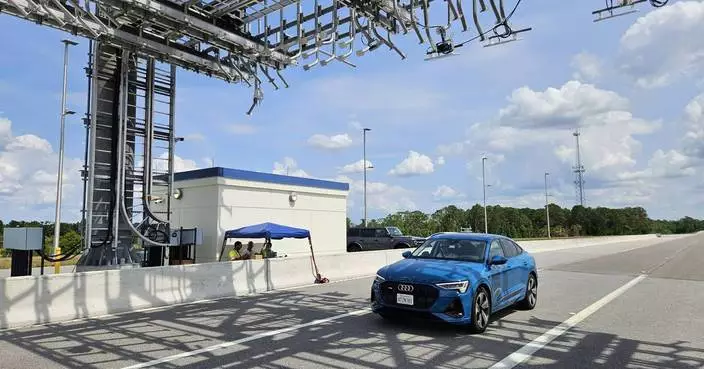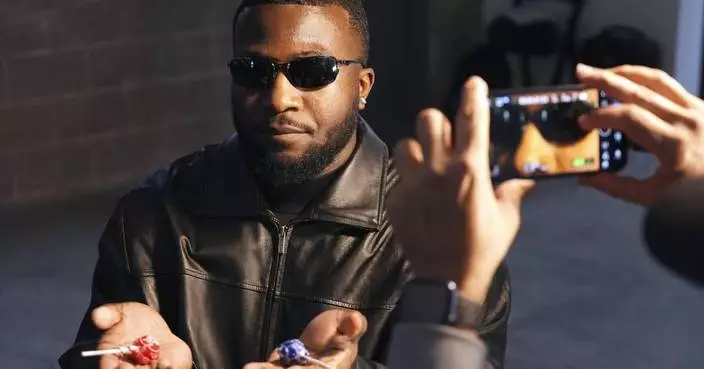For many people, chemical reactions may mean tedious laboratory work and complex equations. But Liang Yan, creator of the award-winning series Beautiful Chemistry and Envisioning Chemistry, has made them fall in love with chemistry.

Liang Yan/online photo

online photo
Liang's videos reveal stunning details that are sometimes invisible to human eyes. Under the microscope, people see metals, such as magnesium, lithium, and iron powders burn like trees and flowers.
The videos were highly recommended by Time.com, which says that "even though chemistry is not your subject and you are asleep for the whole class, you'll still fall in love with it after watching Beautiful Chemistry."

online photo

online photo
The goal is to let more people know that chemistry is a very beautiful subject, said Liang, a scientist with a background in chemistry. Liang graduated from Tsinghua University and got a doctorate degree in chemistry from the University of Minnesota in the United States.
He wants more people to feel the same wonder and excitement he felt when he first witnessed the magnificent reaction between a drop of silver nitrate and sodium chloride.

online photo

online photo
Taking advantage of his proficiency in photography, Liang started making videos.
A cuvette was used to hold the chemical reactions, because its surface is smooth, and could vividly display the visual effects of the reactions, Liang said.

online photo

online photo
Before Liang, a lot of people had videotaped similar chemical reactions. But by letting the process happen in test tubes, it was hard to see the beauty of the reactions with the naked eye, due to distractions caused by reflections or distortions.
Liang and his colleagues didn't add special effects to the videos in order to honestly reflect the chemical reactions.
STOCKHOLM (AP) — The announcement Monday that three laureates will share the Nobel memorial prize in economics for explaining innovation-driven growth brings this year's Nobel awards to a close.
All but the Nobel Peace Prize, which was announced on Friday in the Norwegian capital, Oslo, are announced in Stockholm. The award ceremonies will be held on Dec. 10, the anniversary of the death of Alfred Nobel, who founded the prizes.
Here are this year's winners:
On Oct. 6, the Nobel Prize in medicine was awarded to three scientists for their work on the immune system.
Mary E. Brunkow, Fred Ramsdell and Dr. Shimon Sakaguchi uncovered a key pathway the body uses to keep the immune system in check, viewed as critical to understanding autoimmune diseases such as Type 1 diabetes, rheumatoid arthritis and lupus.
In separate projects, the trio identified the importance of what are now called regulatory T cells. Scientists are using those findings in a variety of ways: to discover better treatments for autoimmune diseases, to improve organ transplant success and to enhance the body’s own fight against cancer, among others.
Brunkow, 64, is now a senior program manager at the Institute for Systems Biology in Seattle. Ramsdell, 64, is a scientific adviser for San Francisco-based Sonoma Biotherapeutics. Sakaguchi, 74, is a distinguished professor at the Immunology Frontier Research Center at Osaka University in Japan.
On Oct. 7, the Nobel Prize in physics was awarded to another trio of scientists for their research on the “weirdness” of subatomic particles called quantum tunneling. That has enabled the ultrasensitive measurements achieved by MRI machines and laid the groundwork for better cellphones and faster computers.
The work by John Clarke, Michel H. Devoret and John M. Martinis took the seeming contradictions of the subatomic world — where light can be both a wave and a particle, and parts of atoms can tunnel through seemingly impenetrable barriers — and applied them in the more traditional physics of digital devices. The results of their findings are just starting to appear in advanced technology and could pave the way for the development of supercharged computing.
Clarke, 83, conducted his research at the University of California, Berkeley; Martinis, 67, at the University of California, Santa Barbara; and Devoret, 72, is at Yale and also at the University of California, Santa Barbara. Clarke spearheaded the project.
On Oct. 8, another scientific trio won the Nobel Prize in chemistry for their development of new molecular structures that can trap vast quantities of gas inside. Experts say the work lays the groundwork to potentially suck greenhouse gases out of the atmosphere or harvest moisture from desert environments.
Experts say the work of Susumu Kitagawa, Richard Robson and Omar M. Yaghi “may contribute to solving some of humankind’s greatest challenges.”
Kitagawa, 74, is with Japan’s Kyoto University, while Robson, 88, is affiliated with the University of Melbourne in Australia. Yaghi, 60, is with the University of California, Berkeley.
On Oct. 9, Hungarian writer László Krasznahorkai won the Nobel Prize in literature for work the judges said upholds the power of art in the midst of “apocalyptic terror.” His surreal and anarchic novels combine a bleak world view with mordant humor.
Krasznahorkai, 71, has written more than 20 books, including “The Melancholy of Resistance,” a surreal, disturbing tale involving a traveling circus and a stuffed whale, and “Baron Wenckheim’s Homecoming,” the sprawling saga of a gambling-addicted aristocrat.
Krasznahorkai has been a vocal critic of autocratic Hungarian Prime Minister Viktor Orbán, especially his government’s lack of support for Ukraine after Russia launched an all-out war.
On Oct. 10, María Corina Machado of Venezuela won the Nobel Peace Prize, and was lauded for being a “key, unifying figure in a political opposition that was once deeply divided.”
Machado, who turned 58 this week, was set to run against President Nicolás Maduro in last year’s presidential election, but the government disqualified her. The lead-up to the election saw widespread repression, including disqualifications, arrests and human rights violations. Maduro’s government has routinely targeted its real or perceived opponents.
Machado went into hiding and hasn't been seen in public since January, and as a result it's unclear whether she will attend the awards ceremony in Stockholm in December.
Machado becomes the 20th woman to win the Nobel Peace Prize, of the 112 individuals who have been honored.
On Oct. 13, Joel Mokyr, Philippe Aghion and Peter Howitt won the Nobel memorial prize in economics. They were honored for their research into the impact of innovation on economic growth and how new technologies replace older ones, a key economic concept known as “creative destruction.”
The winners represent contrasting but complementary approaches to economics. Mokyr is an economic historian who delved into long-term trends using historical sources, while Howitt and Aghion relied on mathematics to explain how creative destruction works.
Dutch-born Mokyr, 79, is from Northwestern University; Aghion, 69, from the Collège de France and the London School of Economics; and Canadian-born Howitt, 79, from Brown University.

John Clarke sits in his Berkeley, Calif., home after becoming one of the three scientists to win the Nobel Prize in Physics, Tuesday, Oct. 7, 2025. (AP Photo/Noah Berger)

Professofr Susumu Kitagawa speaks at a press conference at Kyoto University in Kyoto, western Japan Thrusday, Oct. 9, 2025, a day after he was awarded the Nobel Prize in chemistry. (Kai Naito/Kyodo News via AP)

FILE - Hungary's Laszlo Krasznahorkai poses for photographers in London, Tuesday, May 19, 2015. (AP Photo/Matt Dunham, File)

FILE - Maria Corina Machado leads a protest against the reelection of President Nicolás Maduro one month after the disputed presidential vote which she claims the opposition won by a landslide, in Caracas, Venezuela, Wednesday, Aug. 28, 2024. (AP Photo/Cristian Hernandez, File)

FILE - A Nobel Prize medal is displayed before a ceremony at the Swedish Ambassador's Residence in London, Monday, Dec. 6, 2021. (AP Photo/Matt Dunham, File)






















